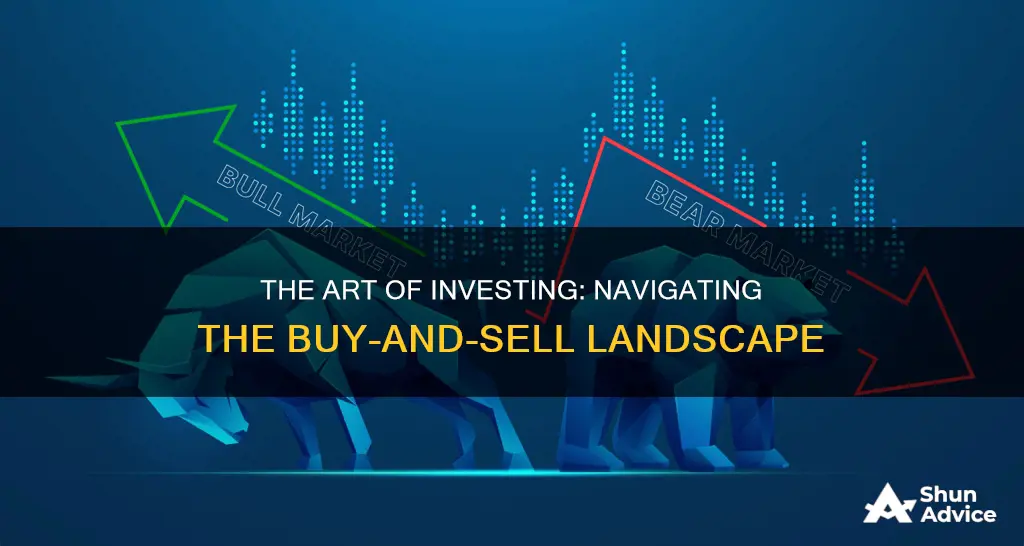
Investing in stocks is a great way to grow your wealth over time. However, it's important to remember that investing involves a chance of losses, and it can be a risky endeavour.
To get started with buying and selling stocks, you'll first need to open a brokerage account. You can choose between a full-service broker, which is more expensive but provides expert investment research and advice, or an online/discount broker, which is cheaper but provides no investment advice. You can also buy stocks online without a broker through a direct stock purchase plan (DSPP), although this can be cumbersome.
Once you've chosen your brokerage and set up your account, you can start researching and choosing which stocks to buy. It's recommended to follow a buy-and-hold strategy, focusing on stability, a strong track record, and the potential for steady growth rather than risking it all on risky stocks.
It's also important to only invest money you can afford to lose and to have a clear understanding of your risk tolerance and investment goals.
By following these steps, you can begin your journey towards building wealth through stock investing.
| Characteristics | Values |
|---|---|
| Investment goals | Short-term and long-term goals |
| Investment amount | Based on income sources, emergency fund, debts, and budget |
| Risk tolerance | High, moderate, or low |
| Investment style | DIY or professional guidance |
| Investment account | Brokerage account, retirement account, or managed account |
| Funding method | Bank transfer, check deposit, or transfer from another brokerage |
| Stocks to buy | Blue chips, dividend stocks, growth stocks, defensive stocks, or ETFs |
What You'll Learn
- Choose a brokerage platform: Compare different brokers to find the investment account that works for you
- Set up your account: You'll need to provide personal information and decide whether to open a cash or margin account
- Fund your account: Transfer money from your bank account or roll over an existing brokerage account
- Choose your stocks: Look for stability, a strong track record, and the potential for steady growth
- Place your order: Decide on the type of order you want to place (e.g., market or limit order) and enter the required information on your broker's platform

Choose a brokerage platform: Compare different brokers to find the investment account that works for you
Choosing a brokerage platform is an important step in your investment journey. Here are some key factors to consider when comparing different brokers to find the investment account that works for you:
Investment Goals and Priorities
Before you start your search, it's crucial to understand your investment goals and priorities. Are you looking to invest in individual stocks, or are you interested in long-term retirement funds? Do you want to focus on passive investments or try your hand at day trading? Knowing your investment strategy will help you choose a broker that aligns with your goals.
Commissions and Fees
Different brokers charge varying commissions and fees for trading different types of securities. Some brokers offer commission-free trading for stocks, ETFs, and options, while others may charge per trade or per share. Additionally, consider other fees such as account maintenance fees, transfer fees, and withdrawal fees. Evaluate the fees associated with the investments you plan to make to find the most cost-effective broker for your needs.
Trading Platforms and Tools
The quality and features of a broker's trading platform are essential for your investment experience. Look for a platform that offers the tools and resources you need, such as charting capabilities, screeners, watchlists, and alerts. If you're a beginner, opt for a platform with educational resources, tutorials, and customer support. More advanced investors may prefer a platform with advanced customisation, in-depth analysis tools, and conditional order options.
Reliability and Customer Service
Choose a broker with a strong track record of reliability and excellent customer service. Consider how long the broker has been in business and their performance during market fluctuations. Evaluate their customer support options, response times, and the knowledge of their representatives. It's also beneficial to look for a broker that offers 24/7 support through various channels like phone, email, and live chat.
Account Minimums and Convenience
Some brokers require a minimum initial investment, so check to see if this aligns with your budget. Also, consider the convenience of the broker's services. For example, if you prefer in-person interactions, look for a broker with physical branch offices near you. Additionally, evaluate the process of depositing and withdrawing funds to ensure it suits your needs.
Promotions and Bonuses
While promotions and bonuses shouldn't be the sole deciding factor, they can help sway your decision if you're torn between two similar brokers. Many brokers offer incentives like cash bonuses for new customers or when you refer a friend.
By carefully considering these factors and comparing different brokerage platforms, you can find the investment account that aligns with your goals, offers the tools you need, and provides a positive overall experience.
Congress Considers Investment Fee Deduction: What's the Verdict?
You may want to see also

Set up your account: You'll need to provide personal information and decide whether to open a cash or margin account
Setting up a brokerage account is a relatively simple process, but it's important to do your research first.
First, you'll need to decide what type of account you want to open. You can choose between a cash account or a margin account. With a cash account, you can only invest the money you have. With a margin account, you can borrow money from the broker to invest, but you'll pay interest on the amount borrowed. Margin accounts also make funds available faster after a sale or deposit.
Next, you'll need to choose a brokerage firm. Consider the services offered, the level of guidance you want, the costs, and any account minimums. You may also want to think about whether you want access to an in-person advisor and whether the firm has branch offices in your area.
Once you've chosen a firm, you can fill out the application form online or in person. You'll need to provide personal information, such as your Social Security number, contact details, and driver's license. You may also be asked about your net worth, employment status, and investment goals.
After your application has been approved, you can fund your account by transferring money from your bank account, writing a check, or transferring assets from another brokerage firm.
Finally, you can start investing! Choose the types of investments you want to make, such as mutual funds or ETFs.
The Road to Recoup: Understanding Investment Payback Periods
You may want to see also

Fund your account: Transfer money from your bank account or roll over an existing brokerage account
Funding your brokerage account is a simple process, but there are a few things to keep in mind. You can transfer money from your bank account or roll over an existing brokerage account. Here's a step-by-step guide to help you fund your account:
Transfer Money from Your Bank Account
- Choose a brokerage account type: Decide between a traditional brokerage account or a retirement brokerage account (IRA). A traditional account offers more flexibility, while an IRA has tax advantages for retirement savings.
- Select a brokerage firm: Research and compare different brokerage firms based on their costs, incentives, services offered, and convenience. Consider factors such as commission fees, research tools, trading platforms, and customer support.
- Open an account: Once you've chosen a brokerage firm, fill out the new account application online. Provide the required information, such as your Social Security number, driver's license, and bank account details if you plan to transfer funds electronically.
- Fund your account: You can transfer funds from your bank account to your brokerage account using electronic funds transfer (EFT), wire transfer, or check deposit. Some brokers may also allow you to mail in paper stock certificates. Keep in mind the minimum funding requirements for different account types.
Roll Over an Existing Brokerage Account
- Choose a rollover IRA provider: If you're rolling over an employer-sponsored retirement plan, such as a 401(k), you'll need to choose a rollover IRA provider. You can use an existing IRA or open a new one with an online broker or robo-advisor.
- Request a direct rollover: Contact your previous employer's plan administrator and request a direct rollover. They will provide you with the necessary forms to process the rollover. This ensures that your funds are directly transferred to your new IRA without any tax implications.
- Provide necessary information: Gather the required information from your new IRA provider, including account details and instructions on how the funds should be transferred.
- Complete the rollover process: Submit the forms to your previous employer's plan administrator and wait for them to process your request. It may take a few days for the assets to be transferred to your new IRA.
Remember to consider the fees, investment options, and tax implications associated with each option. By funding your brokerage account, you'll be one step closer to achieving your investment goals.
The Investment Banker's Early Retirement Dream: Fantasy or Reality?
You may want to see also

Choose your stocks: Look for stability, a strong track record, and the potential for steady growth
When choosing stocks to buy, it is important to look for stability, a strong track record, and the potential for steady growth. Here are some key considerations:
Set Clear Investing Goals:
Understand your financial goals and time horizon. Are you investing for the long term or seeking short-term gains? Do you want capital preservation or focus on growth? Knowing your goals will guide your stock choices.
Understand the Business:
Invest in companies you know and understand. Consider the products and services you use daily and the companies behind them. Research their business model, financial health, and competitive advantage. Ensure you trust the management and their ability to make decisions.
Look for Competitive Advantage:
Identify companies with a sustainable competitive advantage, often called a "moat." This could be their brand, intellectual property, network effect, or other factors that give them an edge over competitors. A strong competitive advantage can help protect their market position and drive long-term growth.
Evaluate Stock Valuation:
Determine a fair price for the stock by analysing financial metrics such as price-to-earnings ratio, price-to-sales ratio, or discounted cash flow modelling. Compare these metrics to historical averages and industry peers to identify stocks trading at a reasonable or discounted price.
Buy with a Margin of Safety:
Look for stocks trading below your estimated fair value, creating a "margin of safety." This helps protect against potential losses if your valuation is incorrect. The size of the margin can depend on the stability and predictability of the company's earnings.
Remember, investing in the stock market carries risks, and there are no guarantees. Diversification is essential to manage these risks. It's also crucial to do your research and understand your risk tolerance before making any investment decisions.
Freelancer's Guide to Retirement Investing: Strategies for a Secure Future
You may want to see also

Place your order: Decide on the type of order you want to place (e.g., market or limit order) and enter the required information on your broker's platform
Placing an Order
When you're ready to place an order, you'll need to decide on the type of order you want to make. The two most common types of orders are market orders and limit orders.
Market Order
A market order is a request to buy or sell shares at the current market price. This type of order is typically executed immediately, but it's important to remember that the price is not guaranteed—it can change by the time your order is processed, especially in fast-moving markets. Market orders are a good option if you want to buy or sell shares quickly and are less concerned about the exact price.
Limit Order
A limit order is more specific. It allows you to set the maximum or minimum price you're willing to pay for a stock. For example, if you want to buy a stock at $10, you can place a limit order for that amount. The trade will only be executed if the stock reaches your specified price. Limit orders are useful if you want more control over the price you pay but be aware that they might not be executed immediately, or at all, if the market price doesn't reach your limit.
Stop Order
A stop order, or stop-loss order, is a type of market order that's triggered when a stock reaches a certain price. For example, if you want to limit your losses to 10% on a stock you own, you can place a stop order that will automatically sell the stock if it drops to that price. Stop orders are valuable tools for managing risk in your investment portfolio.
Once you've decided on the type of order, you'll need to enter the required information on your broker's platform. This typically includes the stock's ticker symbol, the number of shares you want to buy or sell, and any special instructions or restrictions you want to place on the order.
Altria's Juul Gamble: Write-Off or Write a New Chapter?
You may want to see also
Frequently asked questions
You can open a brokerage account online. You will need to provide personal information, such as your Social Security number and address. You will also need to decide what type of account you want, for example, a standard brokerage account or an individual retirement account (IRA).
You should base your choices on long-term value and diversify your holdings to manage risk. You can also buy shares in multiple companies with a relatively small amount of money through fractional share investing.
First, decide how much money you want to invest in each stock, then divide this amount by the stock's current share price.
A market order is typically best for buy-and-hold investors. A limit order allows you to set a specific price at which to buy or sell.
Go to the appropriate section of your online broker's platform and enter the required information, including the company name or stock ticker, whether you want to buy or sell shares, and the dollar amount you want to spend or the number of shares you want to buy.
You can keep adding money to your brokerage account and investing in stocks you'd like to own for the long term. It's important to maintain a long-term mindset and not panic-sell if your stocks' prices decline.







